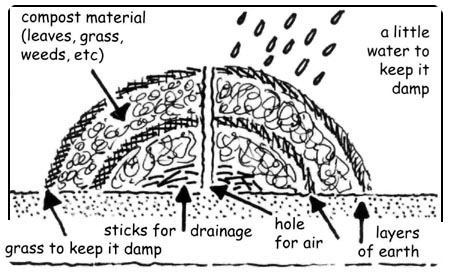Application: Government extension staff, small-scale farmers and farmer groups
Description: The need for maintaining and improving soil fertility in Cambodia in relation to climate change has never been greater. Yet, this needs to be done without recourse to expensive inorganic fertilisers. Teaching farmers how to use waste organic materials as sources of crop nutrients is key to more sustainable agriculture. That is what this publication sets out to do. Compost is organic matter (plant and animal residues) that has rotted due to bacteria and other organisms over a period of time. Many types of organic matter, such as leaves, fruit and vegetable peelings and manures can be used to make compost. The end product is very different from the original materials. It is dark brown, crumbly and has a pleasant smell. Compost is cheap, easy to make and is a very effective material that can be added to the soil, to improve soil and crop quality.
Compost is an effective and long-term improvement of soil to grow better crops. Various commonly available materials such as those mentioned above are excellent for compost making, but many other waste materials produced by households and farms or other activities can be used. Maize stalks used for construction or from kitchen waste can be necessary to feed livestock, but can also be used for the compost heap. Time and effort are necessary to manage a compost heap, and leaving organic matter to pile up, for example, will result in a long time before compost is produced, with nutrients being lost. In a managed heap nutrient loss will be reduced, leaving more nutrients to feed plants. A properly managed compost heap will often generate enough heat to kill weed seeds and plant diseases.
Principles of composting applicable to most methods are:
Contribution to climate resilience: The key benefits from this adaptation option are as follows: (a) high scalability; (b) high relevance at community/farmer level; (c) institutionally highly feasible; and (d) low negative impact on environment, and health and safety. It is considered to have a high impact on climate change adaptation because of improved land and soil management as a result of improved availability of nutrients and organic matter. The negative aspects of this technology are high costs and labour demand, affecting affordability and equity issues. Overall the option is considered to have a high relative score within the MCA.
Supplementary sources of information:
CTA. 1989. Compost-making manual for the Tropics. Spore 24. CTA, Wageningen, The Netherlands.
Background image credit: https://pixabay.com/photos/compost-garden-waste-bio-nature-419259/
This resilience-building measure is sourced from the Adaptation Technologies Guide – Agriculture, Phnom Penh, Cambodia (2019) published by the Ministry of Agriculture, Forestry and Fisheries and the National Council for Sustainable Development at the Ministry of Environment in Cambodia. The full Guide is available to download at URL https://ncsd.moe.gov.kh/sites/default/files/2019-10/Adaptation%20Technologies%20Guide-Agriculture_June%202019_En.pdf


